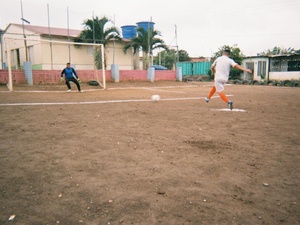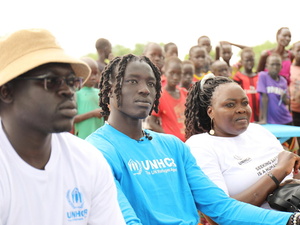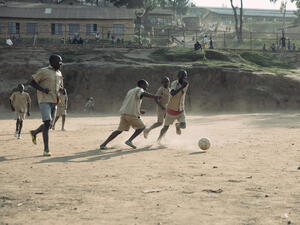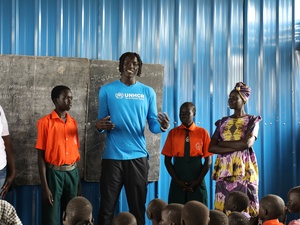Using football to tackle xenophobia in South Africa's townships
Using football to tackle xenophobia in South Africa's townships
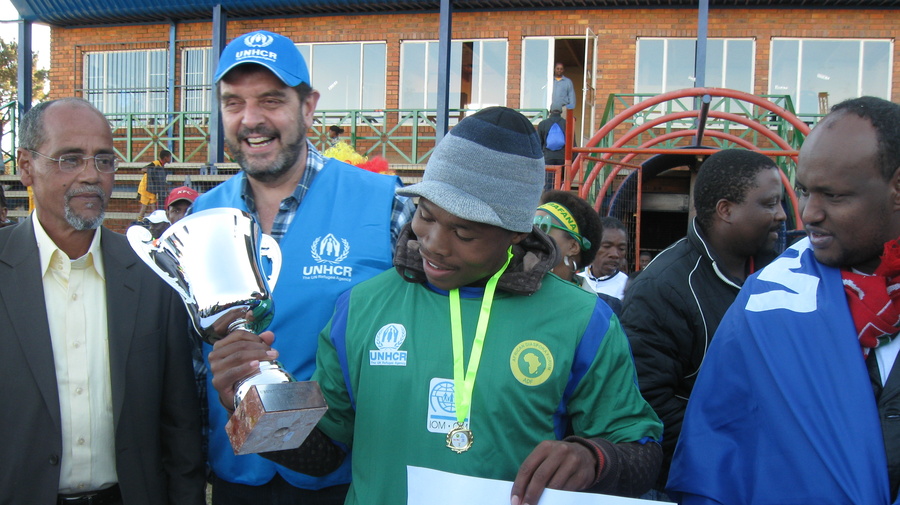
The Randfontein skipper holds the Township Soccer Challenge cup.
JOHANNESBURG, South Africa, June 9 (UNHCR) - With the World Cup finals looming, UNHCR and the International Organization for Migration (IOM) turned to football to tackle the lingering problem of xenophobia in South Africa's townships.
The partner organizations, together with the Africa Diaspora Forum, have just staged a pilot Township Soccer Challenge. The initiative began in May and culminated last Saturday in Mohlakeng, when Randfontein beat Tembisa 5-0 to earn bragging rights to being the best township team in Gauteng Province.
They also won 20,000 rand (US$2,600) to share among the players and 80,000 rand for a community project in Randfontein, a township located to the west of Johannesburg and once famed for its gold mines.
But perhaps the greatest prize for the organizers, spectators and players, including refugees and foreign migrants, was the chance to bridge racial divisions and set an example of solidarity and tolerance to the rest of the country.
There was no sign of the rancour and xenophobia that tore through several South African townships in May 2008, leaving several dozen people dead and forcing thousands of foreigners, including refugees and asylum-seekers, to flee their homes.
The government is determined to avoid a repeat of such scenes when the world's attention is on South Africa during the month-long World Cup football finals, which begin this Friday with a match between the hosts and Mexico in Johannesburg's new Soccer City Stadium.
South African S'busiso Peterson was among those who took part in the pioneering township challenge. The 22-year-old lives in Tembisa, one of the 10 teams taking part in the inaugural event, which UNHCR hopes to replicate in other provinces in the future.
Tembisa was among the townships affected by the violence of two years ago. One reason for the xenophobia was the anger felt by some of the poorest South Africans about the lack of employment opportunities and access to services such as housing, water and sanitation.
"I was so embarrassed by what happened and that is why it is my duty to speak out against xenophobia through what I love doing - playing soccer," the aspiring professional player stressed.
Peterson, who plays for Tembisa, has since reached out to refugees and other foreigners who have returned to the township. Through a common love for football, he was able to bond with people from countries such as Ghana, Malawi, Mozambique and Zambia.
Oko Ashiteng also plays for Tembisa, but he is a Ghanaian and was reluctant to settle in Tembisa after arriving in South Africa last year. "I'd heard a lot about what happened in May 2008 and friends in the Ghanaian community discouraged me from taking up residence in a township," the 18-year-old explained.
But he decided to ignore their advice, in part because he wanted to "play soccer in a place where I would get the opportunity to learn and befriend the locals in their environment. I decided to take the chance and I'm glad I did." Both Peterson and Ashiteng played for Tembisa in the recent Challenge, where they reached the final.
Although the situation has improved considerably since May 2008, intolerance, racism and xenophobia remain serious problems in South Africa. In recent weeks, for instance, property owned by refugees and other foreigners was looted and vandalized during protests about services in the provinces of Gauteng, Mpumalanga and the Free State.
Some people, including Ashiteng, fear xenophobia could rear its ugly ahead again after the World Cup, which ends on July 11. His friend Peterson was more sanguine. "I can't imagine it happening again. We won't allow it," he insisted.
Initiatives like the township challenge can play an important role in preventing such a recurrence and in building bridges between the different communities. "I couldn't tell the difference between a foreigner and a South African. All I saw were people playing well together,' said one young spectator.
By Pumla Rulashe in Johannesburg, South Africa


